
The interviews led by Daehyung Lee, the Artistic Director of the project Dialogue, were conducted with the directors of 9 galleries selected as outstanding galleries in Dialogue, a project presented as a part of a report on the achievements of the Grant for Artist Management program. The course of the directors’ life, concerns about promoting Korean art, future strategies for entering the global market and the directors’ anecdotes with their artists were discussed in the interviews.
The Artistic Director of the project Dialogue, Daehyung Lee, values the social role of art in the era of the 4th industrial revolution in the 21st century (critically essential). Lee is expanding the scope of contemporary curation to the environment, community, technology, and the future. Daehyung Lee directed Korean Pavilion in 2017 Venice Biennale and he led the success of CONNECT, BTS – a global public art project exhibited in five cities including Seoul, New York, London, Berlin and Buenos Aires. Lee organized Korea Research Fellow, a research network of 10 domestic and 10 overseas curators from 2018 to 2021 and has also served as a judge for the 40 UNDER 40 of the London art magazine, APOLLO in 2022.

gallerychosun

gallerychosun director Misung Kwon
Q. “A very kind person.” You are known in the art world for your gentle leadership. You also have a very special 12-year relationship with artist Jeong-ju Jeong. It’s certainly not an easy thing to trust an artist and support him/her without being swayed by the trends and temptations of the art market. You have been introducing Korean contemporary art in various media and genres, such as painting, sculpture, video, and installation. Do you have special standards you abide by in selecting artists and artworks?
I am flattered. As for standards, it is really hard for me to pin point something specifically. Looking back on the past years I have worked as a gallerist, I think I can say that I wasn’t drawn to artworks if they were not those of artists who fiercely studied and explored contemporary values. I support artists with unrivaled identities through which they can generate new art historical meanings and stories. I also prefer artists with whom I can grow with in the mid-to-long run over those who are obsessed with gaining and maintaing popularity in the market. With regard to Jeong-ju Jeong, I was drawn to his unique work at first, but what really sustained our relationship was the artist’s attitude—he is patient and only focused on his work. That attitude has led us to wonderful results recently.

Jeong-ju Jeong,〈27 Rooms〉, 2017, stainless steel, monitor, 120 x 30 x70 cm, Image provided by gallerychosun

Jeong-ju Jeong,〈Star〉, 2022, Stainless Steel, LED, Size variable, Image provided by gallerychosun
Q. The art scene in Korea has been transforming rapidly, both quantitatively and qualitatively, since Frieze Seoul. Some have a rosy outlook while others are concerned that the shadow cast may be as big as the strength of the spotlight we witnessed. What are the attitude and value that artists must uphold in this unprecedented boom of the art market where Korea is in the limelight?
As you said, it is the boom of the art market in Korea that the world is paying attention to, meaning that the global art market is doing well in Korea, not that there is that much more interest in Korean artists. We must look squarely at this reality. I expect that there will be many propositions led by the rosy outlook of the future, however, artists and galleries must find and dedicate themselves to work that they must do without being swayed. Once a few tumultuous years have past, the Korean art scene will become equipped with a top-notch validating system and the ability to discern good artists among the many. That means that artists, who must appeal to the public with symbolic values, now have a lot to prepare in order to create various, sustainable symbolic values. Schools, galleries, museums, and the media must break away from working in silos and work in solidarity to demostrate the best of collective intelligence. Stories that people will remember and share cannot be made by a single individual or entity alone. Artists and galleries must diligently carry out their responsibilities in their respective places, starting with the very basics, with a long-term perspective.
Q. Multinational exchange and collaboration is becoming a new requirement for survival in the art world. What is gallerychosun’s global collaboration strategy and vision?
What I noticed at this year’s Frieze Seoul and KIAF is that Frieze had a flawless manual and moved in perfect order, while the Korean art scene was not systematically ready. I thought that there won’t be a future for us if we fail to analyze our problems and learn the advanced system quickly. The success of global partnership will be determined by whether there is exchange of similar values in a situation where the two parties stand at different places. gallerychosun plans to participate in various art fairs overseas to promote Korean artists abroad, and we will carefully identify our partner who will be most helpful in promoting them. The partner we are most interested in working together is in North America. The best scenario would be to hold an exchange group exhibition of artists we represent. Korea Arts Management Service’s grant program for international exchange exhibition will be very helpful.
Q. Global supply chain competition, war over territories, and the ongoing pandemic are exacerbating the uncertainty about the future. What must art be able to do in such a context?
People who like contemporary art notice reality through art and are also consoled by art. Collecting art became “a cool consumption trend” among the MZ generation recently. Their desire to collect art emerged from the idea of diversifying their investment portfolios upon recognizing the value of art as an asset, but it is also because they long for and admire the life of contemporary artists. Some MZ generation collectors I met said that they are consoled by artists’ life and their art worlds. We must awaken the humanity’s ability to sympathize with others to prevent connections between people from being severed by indications of the new cold war caused by wars and the pandemic and led by “our country first” attitude. What we desperately need in achieving that is art that helps us understand different people, cultures, and thoughts and empathize with them.
Q. Then what is the role of gallerists today?
It may look like the numbers on price tags are all that matter today. However, we need to look far out to the future, not just today, if we are to achieve sustainable growth. That is why we must adopt a mid-to-long term perspective in observing the world and define our partnerships with artists. We must consider if they are partners with whom we can grow together and whether they can establish themselves in art historical discussions, and work in inclusive solidarity with them. We spend a lot of time in working with museums and curators and expanding opportunities to communicate with them. In the end, time is the definitive element. When we bring in new artworks, we hang them up in our office, look at them for a long time, and ask for opinions from many before making decisions about them. Given that we put so much thinking into selecting artworks, it is clear how much preparation and effort are needed to understand artists and the vast scope of their oeuvre as well as support their growth.


